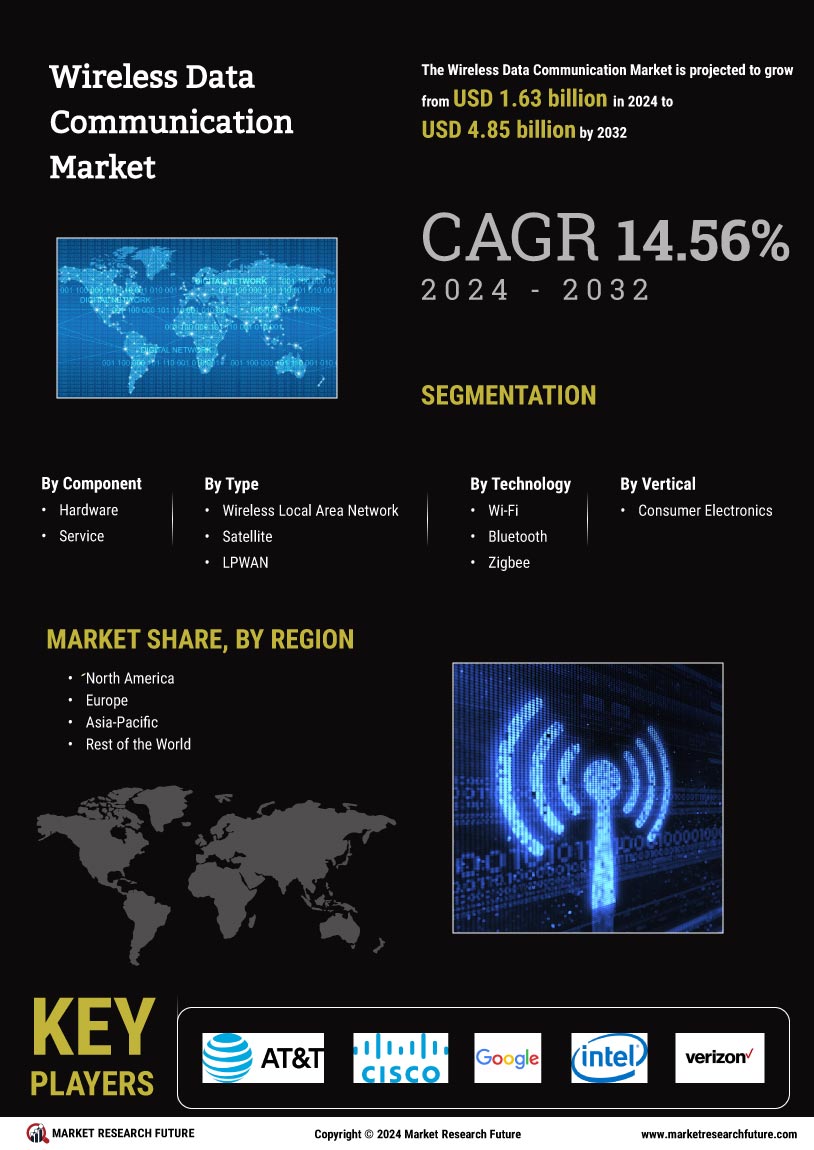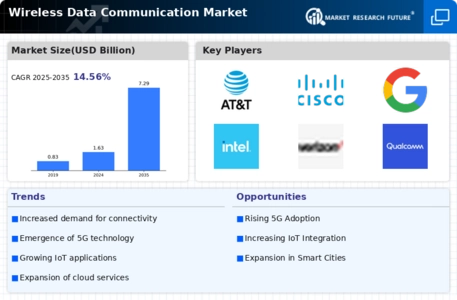Increased Adoption of Mobile Devices
The Wireless Data Communication Market is significantly influenced by the rising adoption of mobile devices. With smartphones, tablets, and wearables becoming ubiquitous, the demand for seamless wireless communication is at an all-time high. Recent statistics indicate that mobile device usage has increased by approximately 50% over the past two years, leading to a corresponding rise in data consumption. This trend necessitates the development of more efficient wireless communication technologies to accommodate the growing number of connected devices. As consumers expect uninterrupted access to information and services, businesses are compelled to enhance their wireless infrastructure. This shift not only drives innovation within the Wireless Data Communication Market but also encourages the integration of advanced technologies such as 5G and Wi-Fi 6, which are designed to support the increasing data traffic generated by mobile devices.
Expansion of Smart Cities Initiatives
The Wireless Data Communication Market is poised for growth due to the expansion of smart cities initiatives. Governments and municipalities are increasingly investing in smart infrastructure to improve urban living conditions and enhance public services. This includes the deployment of smart sensors, connected vehicles, and intelligent transportation systems, all of which rely on robust wireless communication networks. Recent reports suggest that investments in smart city projects are expected to exceed several billion dollars in the coming years. As these initiatives gain momentum, the demand for reliable and high-capacity wireless communication solutions will likely increase. This trend not only supports the growth of the Wireless Data Communication Market but also fosters collaboration between public and private sectors to develop innovative solutions that address urban challenges.
Growing Demand for High-Speed Connectivity
The Wireless Data Communication Market is experiencing a surge in demand for high-speed connectivity solutions. As businesses and consumers increasingly rely on data-intensive applications, the need for faster and more reliable wireless communication becomes paramount. According to recent data, the demand for high-speed internet connections has risen by over 30% in the last year alone. This trend is driven by the proliferation of streaming services, online gaming, and cloud computing, all of which require robust data transmission capabilities. Consequently, telecommunications companies are investing heavily in upgrading their infrastructure to support these demands, thereby propelling the growth of the Wireless Data Communication Market. The shift towards 5G technology further amplifies this trend, as it promises to deliver unprecedented speeds and lower latency, making it a critical factor in the market's expansion.
Advancements in Wireless Communication Technologies
The Wireless Data Communication Market is significantly impacted by advancements in wireless communication technologies. Innovations such as 5G, Wi-Fi 6, and Li-Fi are revolutionizing the way data is transmitted wirelessly. These technologies offer enhanced speed, capacity, and reliability, which are crucial for meeting the demands of modern applications. For instance, 5G technology is projected to support up to one million devices per square kilometer, facilitating the growth of the Internet of Things (IoT) and smart devices. As these technologies continue to evolve, they are expected to drive substantial investments in the Wireless Data Communication Market. Companies are likely to prioritize research and development to leverage these advancements, ensuring they remain competitive in an increasingly connected world.
Rising Importance of Cybersecurity in Wireless Communication
The Wireless Data Communication Market is increasingly shaped by the rising importance of cybersecurity. As wireless communication becomes more prevalent, the potential for cyber threats also escalates. Organizations are recognizing the need to protect sensitive data transmitted over wireless networks, leading to a heightened focus on cybersecurity measures. Recent surveys indicate that nearly 70% of businesses consider cybersecurity a top priority in their wireless communication strategies. This growing awareness is driving the development of advanced security protocols and encryption technologies, which are essential for safeguarding data integrity and privacy. Consequently, the emphasis on cybersecurity is likely to influence the design and implementation of wireless communication systems, thereby impacting the overall trajectory of the Wireless Data Communication Market.


















Leave a Comment